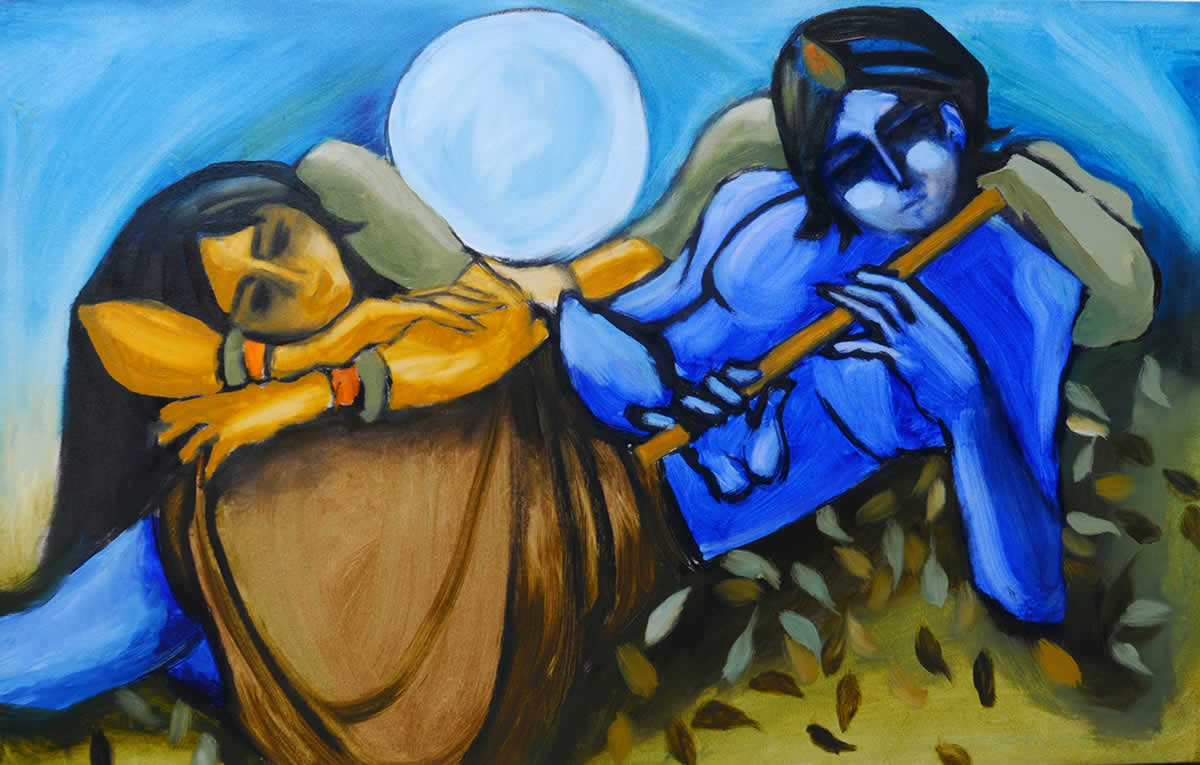Krishna is a major deity in Hinduism. He is worshipped as the eighth avatar of the god Vishnu and also as the supreme God in his own right. He is the god of compassion, tenderness and love in Hinduism, and is one of the most popular and widely revered among Indian divinities. Krishna's birthday is celebrated every year by Hindus on Krishna Janmashtami. Krishna is usually depicted with a flute in his hand.
Krishna’s Life
The anecdotes and narratives of Krishna's life are generally titled as Krishna Leela. He is a central character in the Mahabharata, the Bhagavata Purana and the Bhagavad Gita, and is mentioned in many Hindu philosophical, theological, and mythological texts. They portray him in various perspectives: a god-child, a prankster, a model lover, a divine hero, and as the universal supreme being. His iconography reflects these legends, and shows him in different stages of his life, such as an infant eating butter, a young boy playing a flute, a young boy with Radha or surrounded by women devotees, or a friendly charioteer giving counsel to Arjuna.

Moonlit Sonata, Painting by Artist Milon Mukherjee, Oil on Canvas , 28 x 44 inches
Birth
In Krishna Charitas, Krishna is born to Devaki and her husband, King Vasudeva of the Yadava clan in Mathura. When Mother Earth was burdened by heinous activities of Kamsa and other demon Kings, she went to Lord Brahma in the form of cow who along with other gods took her to shore of milky ocean. There they chanted Purusha Sukta to summon Lord Vishnu. Lord Vishnu assured her and other gods that he would himself take birth along with his part Shesha in Yadu Dynasty to end the tyranny. Devaki's brother is a tyrant named Kamsa. At Devaki's wedding,
according to Puranic legends, Kamsa is told by fortune tellers that a child of Devaki would kill him. Kamsa arranges to kill all of Devaki's children.
When Krishna is born, Vasudeva secretly carries the infant Krishna away across the Yamuna and exchanges him. When Kamsa tries to kill the newborn, the exchanged baby appears as the Hindu goddess Durga, warning him that his death has arrived in his kingdom, and then disappears, according to the legends in the Puranas. Krishna grows up with Nanda Baba and his wife Yasoda near modern-day Mathura. Two of Krishna's siblings also survive, namely Balarama and Subhadra, according to these legends. The day of birth of Krishna is celebrated as Krishna Janmashtami.
Childhood and youth
The legends of Krishna's childhood and youth describe him as a cow herder, a mischievous boy whose pranks earns him the nickname a Makhan Chor (butter thief) and a protector who steals the hearts of the people in both Gokul and Vrindavana. The texts state, for example, that Krishna lifts the Govardhana hill to protect the inhabitants of Vrindavana from devastating rains and floods.
Other legends describe him as an enchanter and playful lover of the gopis (milkmaids) of Vrindavana, especially Radha. These metaphor-filled love stories are known as the Rasa lila and were romanticised in the poetry of Jayadeva, author of the Gita Govinda. They are also central to the development of the Krishna bhakti traditions worshiping Radha Krishna.
Krishna's childhood illustrates the Hindu concept of lila, playing for fun and enjoyment and not for sport or gain. His interaction with the gopis at the rasa dance or Rasa-lila is an example. Krishna plays his flute and the gopis come immediately, from whatever they were doing, to the banks of the Yamuna River and join him in singing and dancing. Even those who could not physically be there join him through meditation. He is the spiritual essence and the love-eternal in existence, the gopis metaphorically represent the prakṛti matter and the impermanent body.
This lila is a constant theme in the legends of Krishna's childhood and youth. Even when he is battling with a serpent to protect others, he is described in Hindu texts as if he were playing a game. This quality of playfulness in Krishna is celebrated during festivals as Rasa-lila and Janmashtami, where Hindus in some regions such as Maharashtra playfully mimic his legends, such as by making human gymnastic pyramids to break open handis (clay pots) hung high in the air to "steal" butter or buttermilk, spilling it all over the group.